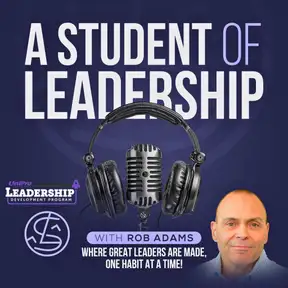Episode 9 - Leadership Communication
Download MP3Hello, and welcome to A Student of Leadership. The podcast that uncovers the secrets of exceptional leaders. Join host Rob Adams as he explores the critical habits and practices that define leadership greatness. One transformative episode at a time. From cultivating a compelling vision to embodying courage, empathy, accountability, and resilience, you'll gain the tools and insights to elevate your leadership impact no matter where you are on your journey.
Otro:Whether you're a seasoned executive or stepping into your first leadership role, each conversation will inspire and equip you to become the leader you were always meant to be. Let's dive in.
Rob Adams:Welcome back to A Student of Leadership where great leaders are made one habit at a time. I'm Rob Adams, and I'm your host today where we are focusing on one of the most important vital skills in leadership, communication. Communication is the bridge between your vision and your team's actions. It's not just about what you say, but how you say it and how well you listen. Great leaders use communication to inspire, align, and connect with their teams, ensuring everyone is moving in the same direction with both clarity and purpose.
Rob Adams:In this episode, we'll explore the art of effective communication, sharing a compelling leadership story, and providing you with actionable steps to elevate your communication skills. Consider the leadership of Sheryl Sandberg, the COO of Meta. During times of organizational change and challenges, Sandberg has been known for her transparent and empathetic communication style. After the loss of her husband, she openly shared her grief journey in her book, option B. And in her work, she emphasized the importance of vulnerability in leadership.
Rob Adams:Sandberg's transparent and empathetic communication style wasn't a one time response to personal and professional challenges, but rather a consistent approach woven throughout her leadership. Her ongoing commitment to vulnerability and authenticity became a hallmark of her leadership style, fostering a culture of openness, resilience, and connection within the organization. Her ability to communicate authentically not only strengthened her personal connection with her team, but also created a culture of openness and resilience within the organization. Sandberg's story reminds us that effective communication is about clear, authentic, and attuned to the needs of those you lead. George Bernard Shaw once said, the single biggest problem in communication is the illusion that it has taken place.
Rob Adams:In the behavioral framework, we see this emphasis on clarity and understanding as a key distinguisher of exceptional communicators. Across context and cultures, leaders who consistently prioritize active listening, feedback, and adapting their message tend to build stronger and more aligned teams. Now ask yourself these questions. When communicating with your team, do you prioritize clarity and understanding? How often do you seek feedback to ensure your message has been received as intended?
Rob Adams:And what steps can you take to improve listening and responding to others? In a 2018 McKinsey and Company article titled The Science of Organizational Transformations, researchers found that effective communication within their teams can increase productivity by up to 25%. They also noted that leaders who communicate clearly and consistently tend to foster higher levels of trust and engagement among their team members. Now, here are 3 practical ways to improve your communication as a leader. Number 1, be clear and concise.
Rob Adams:Avoid jargon or overly complex language. Focus on delivering your message in a way that's easy to understand and actionable. Number 2, listen actively. Practice giving your full attention when others speak. Paraphrase their points to ensure you've understood them and ask follow-up questions to deepen the conversation.
Rob Adams:And number 3, adapt your style. Tailor your communication style to your audience. Whether you're speaking to a large group or having a 1 on 1 conversation, adjust your tone, language, and delivery to meet their needs. Remember, great communication isn't about one perfect conversation or email, but rather a consistent practice of clarity, active listening, and adaptability. Integrating these habits into your daily leadership routines allows you to develop a communication style that becomes a natural and authentic part of your leadership.
Rob Adams:Your action challenge for this week is to identify one upcoming opportunity to communicate with your team. Could be a meeting, delivering an email, or a 1 on 1 conversation. Focus on being clear, listening actively, and adapting your style. Afterwards, reflect on how your approach impacted the interaction. Communication is the foundation of great leadership.
Rob Adams:It's how you connect with your team, how you align on goals, and inspire action. As you work on this week's action challenge, remember that every interaction is an opportunity to build trust and clarity. Communication, like all of the leadership habits we've explored, is a skill that can be honed and strengthened with regular practice. By consistently choosing to communicate with clarity, authenticity, and adaptability, you're not just improving your individual interactions, you're creating a ripple effect of trust, alignment, and action that will uplift your team and organization. Next week, we'll dive into influence, how leaders inspire action and create meaningful impact through their behaviors and decisions.
Rob Adams:Until then, keep practicing the habits that make great leaders. And remember, great leaders are made one habit at a time. See you next time on A Student of Leadership. Take care, everyone.
Otro:Thanks for tuning in to this episode of A Student of Leadership. If you liked what you heard, then be sure to subscribe and share with like minded people. Have a burning question for Rob or a topic you'd love him to discuss on the show? Get in touch on socials. We'd love to hear from you.
Otro:We'll see you next time. And remember, great leaders are made one habit at a time.
Creators and Guests


